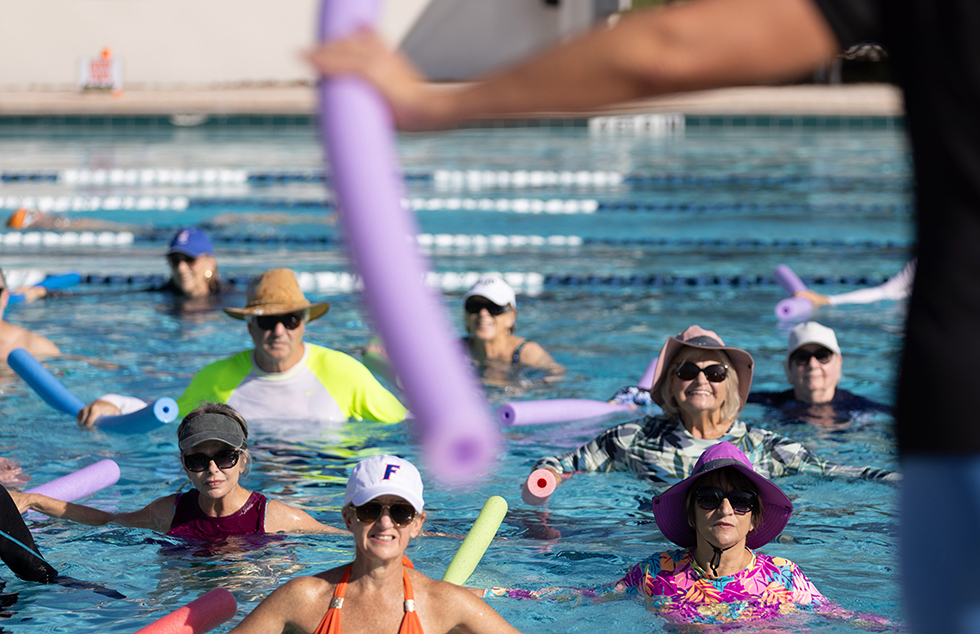Exercise has numerous physical benefits. It can help improve heart health, strengthen bones and joints, improve immune function, and increase energy levels. When it comes to mental health, regular fitness improves mood, relieves stress, improves focus and cognition, enhances self-esteem, and leads to better sleep.
The good news is, you don’t have to run a marathon or spend hours at the gym to reap these benefits. In fact, the motto employed by the U.S. Department of Health and Human Services (HHS) to encourage regular fitness is, “Move more and sit less.”
While this may sound like an oversimplification, the premise is that any movement helps to prevent a sedentary lifestyle – a lifestyle that can increase the occurrence of chronic diseases like cardiovascular disease and type 2 diabetes, as well as certain types of cancer.
Too often, people approach fitness with an all-or-nothing attitude. The key is to view fitness as an integral part of daily life – a way to move more and sit less. “Fitness is wellness, not weight loss,” said Elaine Ragan, Westchase resident and owner of Insane Fit Girls. “The stronger you are the better prepared you are for what life throws at you.”
If you are stuck in a fitness rut or are simply looking for that nudge you need to get up and get moving, it is important to remember you are not alone. We reached out to some area fitness experts and fellow residents for advice on making fitness an integral part of your life.
Start Slowly
While you may be eager to embark on your fitness journey, the key to long-term success is to start slowly. According to HHS, people should “start low and go slow” by starting with lower-intensity activities and gradually increasing the frequency and duration of the activities.
“The recommendation is 150 minutes of moderate to intense activity per week and two days of strength training; that is 20 minutes per day or 30 minutes, five days per week of moderate to intense exercise, and perhaps 20-30 minutes of weight training two days per week,” explained Shannon Thigpen, Westchase resident, wellness coach and yoga teacher. “However, even that may seem overwhelming. If so, start with 10 minutes per day. The key is to get started and have at least one person that you give permission to hold you accountable.”
Find a Community
Group workouts – whether they are held at a gym, a fitness studio, in a park or at a recreation center – are more than just a form of exercise; they are a source of motivation, support and fellowship. “There are many benefits to working out in a group setting,” said Linda Senkowicz, Westchase resident and certified aquatic fitness professional. “One of them is finding motivation and inspiration from those around you to cheer you on.”
Westchase resident Dina Marcus takes part in the group aqua-fit classes Senkowicz holds at the West Park Village Pool and finds encouragement in the group setting. “I have never been so motivated until I tried out Aqua Fit this summer! I immediately loved it!” Marcus said. “Linda and Lisa [Neiderberger] are excellent instructors who focus on encouragement. There is no pressure or embarrassment. They encourage everyone to adapt the workout to their own needs and abilities.”
“By being part of a community, you can find support and guidance from people who are on the same journey as you,” Senkowicz added. “Whether that journey is to better your health and wellness or improve your strength and endurance, there will always be someone who has your back. You will also be held accountable by your peers when you don’t come to class!”
Group classes are also key to keeping your fitness routine fresh and options abound in our area. The YMCA offers group classes in everything from HIIT (high-intensity interval training) and Zumba to cycling and yoga. The Westchase Recreation Center offers morning Tone & Stretch classes that are popular with local seniors, basketball league play, Bollywood classes and much more. And we are surrounded by local fitness centers offering group workouts in everything from martial arts to Pilates.
“Group exercise is a great way to add variety to your workout and prevent a plateau,” Senkowicz stated. “Because different trainers have different styles of teaching, you will never get bored. You will also have the benefit of professionals showing you how to do each move with the proper form.”
Get One-on-One Help
For those who prefer a bit more privacy in their workouts, but are still looking for guidance, personal training is a great option. Westchase-based The Exercise Coach offers customized 20-minute workouts led by certified fitness coaches that offer maximum results in a minimal amount of time.
At 20 Minutes to Fitness in Carrollwood, personal trainers guide you through a total body workout with a focus on slow, continuous movements that can be fine-tuned to any fitness level. The YMCA also offers sessions with a personal trainer, whether you are looking to try something new or simply need an accountability partner.
Adjust with Age
While key HHS guidelines for physical activity vary across age groups, fitness is important at all ages. Preschool-age children (3-5) should engage in a variety of play-based activities throughout the day. Children ages 6-17 should do 60 minutes or more of moderate-to-vigorous physical activity daily. “Kids establish habits easier than adults, so if they establish fitness habits early, they become a more integrated part of their lives, which helps keeps them mentally and physically fit,” said Ragan. “With kids being stationary throughout much of the school day, finding time for movement can keep them engaged and focused and keep them from becoming too sedentary.”
For adults, substantial health benefits require at least 150 minutes a week of moderate-intensity, or 75 minutes a week of vigorous-intensity aerobic activity, plus strength-training exercises that involve all major muscle groups on two or more days a week. Additional health benefits are gained by engaging in physical activity beyond these recommendations.
Exercise has additional benefits as we age. According to HHS guidelines, older adults should follow the guidelines for adults as they are able, incorporating multicomponent physical activity that includes balance training, as well as aerobic and muscle strengthening activities. “The added benefits for older adults include maintaining independence by staying strong,” Thigpen stated. “As you age, you lose muscle and balance. You need both for daily activities like getting out of a chair and reaching up into a cabinet.”
“Bone density, range of motion and muscle atrophy are definitely things that should be considered when deciding on an exercise routine as we age,” Ragan added. “Weight management is helpful in keeping some diseases at bay and strength training keeps our muscles strong, which can help our posture, range of motion, bone density and overall quality of life. The routine doesn’t need to be overwhelming; it should be enjoyable. Fitness in our senior years helps us maintain an independent quality life.”
Adapt to Changing Circumstances
It is also important to give yourself permission to adjust your workouts to meet you where you are in life. Perhaps you are struggling to balance the demands of work and home, or simply can’t find enough hours in the day to fit everything in. It is important to stay active, especially to help combat those daily stressors, but your fitness routine might look a bit different – and that is ok! “I was going [to aqua fit] three times a week. I’m down to two only because of my work schedule,” Marcus noted.
“Sometimes life allows us four days a week of hard-core workouts, and sometimes life allows us a walk with a friend to clear our mind and get some steps in,” Ragan added. “We don’t have to be in an all-or-nothing situation. I have girls that come four days a week consistently for 10 years and I have others who make it once a week or maybe only once a month and they are all welcome with appreciation and enthusiasm.”
There are also times when our bodies dictate the need for a shift in our activities. Maybe your knees are telling you it’s time to switch from a daily run to a brisk walk. Or perhaps you are trying to get back into a fitness routine after an illness or injury and CrossFit just isn’t in the cards at the moment. There are plenty of low-impact and moderate- to low-intensity fitness options that offer a great workout and some added benefits. Both Pilates and yoga build strength, increase flexibility and reduce tension in the back and shoulders. They also promote mindfulness and breathwork that can help combat life’s daily stressors.
Jiu Jitsu is a martial art that offers an effective workout for people of all ages and skill levels, while also teaching self-defense techniques and building confidence.
Walking just 30 minutes a day can increase cardiovascular fitness, strengthen bones, reduce excess body fat, and boost muscle power and endurance. Our neighborhoods and county parks are packed with opportunities for scenic walks that get us out into nature, which offers added mental health benefits.
Aqua fit is another great option. Senkowicz noted that while aqua fit classes are often associated with seniors, they offer a fun and effective workout for people of all ages and fitness levels. “The resistance of the water is about 12 times the level of air resistance. Because of this, it is a total body workout,” Senkowicz said. “Just by moving your body in the water, no matter which way you move, there is resistance. Some classes use equipment to further increase the resistance of the water which intensifies the workout and strength gains.”
Because the water bears the brunt of your weight during aqua fit, these classes are especially beneficial to those with arthritis, pregnant women, seniors, individuals who are overweight and those recovering from an injury or surgery. “I find it is great for my joints. It is low impact, but still a challenge,” Marcus said.
And there are added benefits for seniors. “[Aqua fit] exercises are specifically tailored to improve muscle tone, coordination, strength and balance to help reduce the risk of falls,” Senkowicz added.
No matter where you are in life, the key is to keep moving in a way that works for you – remember, move more and sit less.
Do What You Enjoy
You don’t have to love every second of your workout, but you should at least get some pleasure from your fitness pursuits. “Fitness is different for everyone. I think people here workout and they think they need to join a bootcamp or a gym, but they don’t consider the other activities available like dance classes, Zumba, Pilates, yoga, running groups, walking with a friend to get started or a personal trainer because you need the one-on-one accountability,” Ragan said.
The key is finding the type of activity that appeals to you so that it sticks. Some love the rigor of a high-intensity boot camp, while others find satisfaction in that runner’s high. Others prefer a more laid-back hike in the great outdoors or a bike ride through the neighborhood.
Perhaps you miss the pursuits of your youth and enjoy getting your activity in through an adult sports league or a dance workout. Or maybe you find a sense of peace in the mind-body connection in a yoga, Pilates or martial arts class.
“For my fitness routine, I incorporate daily walking and Pilates classes,” stated Westwood Lakes resident and WOW writer Danielle Hauser. “Though I had never tried Pilates before, I was hooked after taking one class. It’s great for building strength, flexibility and balance, plus you get a full body workout. Pilates is perfect for people of all ages and fitness levels. An added bonus is that I’ve made many new friends which makes me look forward to going to class.”
With the wealth of options available in our area, it is easy to find the one that is right for you.




